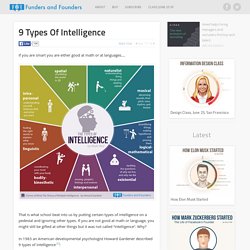

Annie Murphy Paul: Brilliant: The Science of How We Get Smarter. 9 Types Of Intelligence - Funders and Founders. If you are smart you are either good at math or at languages….

Rationality. Cognitive Biases. Creativity. Introversion. Genius. The Heritability of Intelligence: Not What You Think. One of the longest standing assumptions about the nature of human intelligence has just been seriously challenged.

According to the traditional “investment” theory, intelligence can be classified into two main categories: fluid and crystallized. Differences in fluid intelligence are thought to reflect novel, on-the-spot reasoning, whereas differences in crystallized intelligence are thought to reflect previously acquired knowledge and skills. According to this theory, crystallized intelligence develops through the investment of fluid intelligence in a particular body of knowledge.
As far as genetics is concerned, this story has a very clear prediction: In the general population– in which people differ in their educational experiences– the heritability of crystallized intelligence is expected to be lower than the heritability of fluid intelligence. School achievement isn't just in your genes - opinion - 18 October 2013. Read full article Continue reading page |1|2 Anyone who asserts that educational attainment is in large part inherited needs a lesson in modern genetics, says a professor of biology Is intelligence genetically determined?

You might think so, if you saw the headline-grabbing report from UK education advisor Dominic Cummings. The 240-page essay was a parting gift to his boss, education minister Michael Gove. The heritability claim depends on two assumptions: that we can define and measure intelligence; and that we can unpick the contributions of genes and environment. Attempts to measure intelligence stretch back to early last century, when the French psychologist Alfred Binet devised a series of tests for schoolchildren of different ages, to help teachers identify those who could benefit from extra help. By the 1920s, however, tests had been developed for adults and their purpose had changed.
Elastic IQ Less rigid psychometricians began to speak of multiple intelligences. More from the web. Studies Contest Theory that Internet Is Making People Dumber. Vincent is sitting on the couch and watching a vacation video when he suddenly poses two questions to his parents: "Why is space endless?

And what was there before the Big Bang? " Without waiting for an answer, Vincent jumps up to turn his attention to a different topic: his new red rubber boots with pictures from the animated film series "Cars. " "I want a puddle! " Vincent shrieks, dancing around the room in excitement.
"Then I can jump in it and splash you! " Vincent T. is 4 years old. That means Vincent is gifted. Children like Vincent -- little superbrains who devour stories of Winnie-the-Pooh and reports on the Mars rover Curiosity with equal enthusiasm -- are increasingly common. And Heidi is not even Mensa's youngest member. This obsession with numbers is not without its controversies. A Mind-Boggling Trend In the book, Flynn offers a level-headed analysis of the limits and possibilities of intelligence tests.
Developing countries such as Kenya are also making gains. Virtues of Cognitive Workout: New Research Reveals Neurological Underpinnings of Intelligence. How much does environment influence intelligence?

Several years ago University of Virginia Professor Eric Turkheimer demonstrated that growing up in an impoverished and chaotic household suppresses I.Q. – without nurture, innate advantages vanish. What about genes? Nine Ways To Become Smarter Than You Think. How To Add 2.75 IQ Points Per Hour of Training. 2.5K Flares2.5K Flares × The Wall Street Journal just publicized a scientifically proven technique you can use to increase your IQ. I have been recomending dual N-back exercises The Bulletproof® Executive coaching program. I not only recommend it to my clients, but I have also been using myself (since 2009) and I have had excellent results boosting my IQ at least 18 points (I took standardized IQ tests before and after).
From an efficiency perspective, that’s incredible. I gained 2.75 IQ points for every hour of brain training I did. N-back exercise is simple – a grid of 9 squares is presented on screen like this: Every few seconds one of the 8 squares of the grid (center one isn’t used) lights up with a colored box and a letter is spoken aloud. Here’s a graph of my N level for my first 20 sessions (total of just 6.5 hours of training): See how long I was stuck at N = 4? The best part about N-back training is that it’s permanent. So what does a higher IQ get you? 1. 2. 3. Dual N-Back Training for Intelligence. The Bell Curve And Cognitive Elites. The Bell Curvewas a seminal work on IQ and its impact in society, published in 1994 by psychologist Richard J.

Herrnstein (now deceased) and libertarian political scientist Charles Murray. Its central argument is that human intelligence, measured by IQ tests, is influenced substantially by both inherited and environmental factors, and IQ is better predictor of financial income, job performance, and involvement in crime than are parental socio-economic status or education level. Another thesis of The Bell Curve is that that those with high intelligence, the “cognitive elite”, are becoming increasingly separated from those of average and below-average intelligence – and that this has important social implications. This claim is supported by the facts.